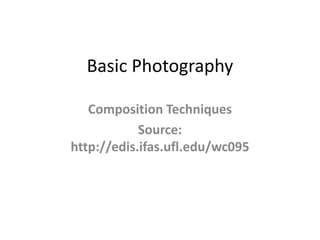
Basic photography composition techniques
- 1. Basic Photography Composition Techniques Source: http://edis.ifas.ufl.edu/wc095
- 2. Composition Techniques • Composition is organizing the subject—the person or object of the photograph—through the viewfinder. • The quickest and surest way to get a sharp, clear picture is to hold the camera correctly. • Blurred pictures are caused most frequently by moving the camera as you press the shutter button
- 3. Focus and Flash • Most cameras' automatic modes do an excellent job of auto-focusing for you. • Pressing the shutter button halfway allows the camera to calculate the focus, white balance, and amount of light. • The focus can also be manually set. Manual focus is used on digital cameras to emphasize one element in focus while de-emphasizing another, which is out of focus.
- 4. Focus and Flash • Digital cameras also have several flash modes. • Most allow you to select a flash, a red-eye reduction flash, or no flash. • The flash setting that the camera chooses when the automatic flash is selected—by pressing the shutter button halfway—is not always correct.
- 5. Focus and Flash • The automatic flash does not always select the best light for an image; rather, it selects light that is neither too dark nor too bright. • If using the automatic flash doesn't produce satisfactory results, use one of the other flash settings. • It is also recommended to stand no closer than 4 feet away from the subject and no farther than 10 feet away to get the best flash lighting. • When taking pictures on sunny days, turn on the flash to help eliminate the harsh shadows produced by sunlight.
- 6. Angles • One of the best ways to create interest in photographs is to vary the angles while framing the shot well. • An unusual angle or viewpoint can add a great deal of interest to an ordinary object. • While it is appropriate to shoot at eye level with the object or person, varying the camera angle from time to time adds a little extra excitement to the photograph.
- 7. Angles • For example, photographed from below, someone looks strong and dominating. From above, a person appears meek, even childlike. • Camera angles refer to the different angles you can hold a camera in reference to the object of interest. • Use your imagination to find different angles or perspectives for your photographs. You might try lying down or crouching in front of an object, climbing above it, or putting the camera on the ground.
- 8. Angles • An eye-level shot looks the subject right in the eye. Some photographers call it the "bull's-eye effect" when the eye-level shot is coupled with placing the person directly in the middle of the picture, creating a "bull's-eye." • A low-angle shot looks up at the object of interest. This angle creates a dramatic look, where everything appears magnified. • Holding the camera high and shooting down is called a high-angle shot, where everything in the shot appears minimized or diminished.
- 9. Rule of Thirds • Perhaps the most well-known principle of photographic composition is the rule of thirds. • The basic principle behind the rule of thirds is to imagine dividing an image into thirds horizontally and vertically so that you have nine parts. • Position the main subject elements where the dividing lines intersect. This means not placing your subject right in the center of the frame. • For example, frame the shot so that the subject's eyes are on the line dividing the upper third from the middle third.
- 10. Types of Photos • News and Feature Photos: A feature photograph is a photograph not tied to a news story. • People Photos • Animal Photos
- 11. People Photos • Avoid posed shots. Do not force people to always pose staring at the camera. Get them doing something. • Take candid pictures. Show people working, playing, or relaxing. • Keep people busy. An interesting prop can give the person being photographed something to work with and can help create a natural feeling. For example, a rodeo cowboy could hold a lasso as his "prop." • Move in close. Fill the camera's viewfinder with the subject to create pictures with greater impact. Standing too far away, even when taking group shots, produces images that are harder to see and less interesting. • Look your subject in the eye. With children, for example, that means getting on their height level.
- 12. Animal Photos • Groom the animal. If it is a grand champion-type photograph, make sure the animal looks its best. An effective livestock photo should show a good side view of the animal so its markings, profile, and general condition are visible. • Show the animal just as it is. Do not use photo editing software to "doctor" the picture. • Choose an appropriate background that does not clutter the picture or distract the viewer's attention from the animal. For example, an open field as a backdrop is probably better than a dark barn. • Position and pose the animal properly. Generally, use a full side view or a three-fourths view, when the animal's head faces more toward the camera than the rest of the body. The animal's head should be high. • Use a flash, if possible. A flash will enhance the animal's appearance by revealing shadow detail.
